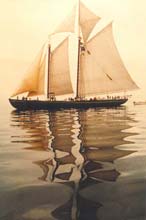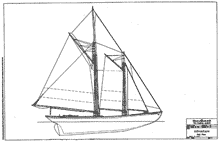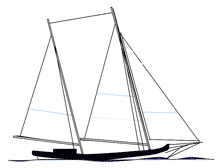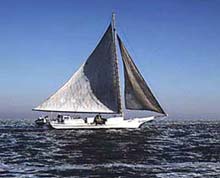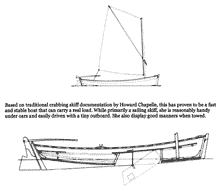
 Custom Search
|
|
| sails |
| plans |
| epoxy |
| rope/line |
| hardware |
| canoe/Kayak |
| sailmaking |
| materials |
| models |
| media |
| tools |
| gear |
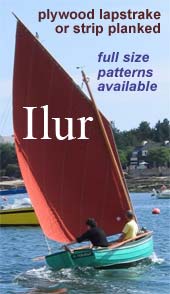 |
 |
| join |
| home |
| indexes |
| classifieds |
| calendar |
| archives |
| about |
| links |
| Join Duckworks Get free newsletter Comment on articles CLICK HERE |
|
|
| Out There |
by Paul Austin - Dallas, Texas - USA Workboats Then and Today - Part Two |
 |
|
Across the ocean, the American glamour girl of workboats is the Gloucestor fishing schooner. Uffa Fox once said the Gloucestor fishing schooners are, 'the finest sailing vessels in the world' (from Sailing, Seamanship and Yacht Construction, 1936). The idea of a fore and aft rig was probably the concoction of the Dutch. However, American designers found great uses for the schooner long after other nations did. Now as to that elusive name, the 1911 Encyclopedia Brittanica claims Andrew Robinson launched a schooner in 1713 to someone's cry, 'Oh how she scoons!', meaning she scoots along. According to Skeat's Etmyological Dictionary, the spelling is an American corruption of 'schoner' (I looked this up, since I know Skeats like Chuck knows ducks). But this view is not shared by many. Maritime scholars think the coincidence of someone in the crowd using the same word the Dutch used 200 years before across an ocean is just too much. But then if scholars don't have something to argue about, what are they gonna do? Caulk? The Gloucestor fishing schooners had to be swift - therefore narrow. But they had to have the capacity to hold fish for market. And yet they had to be seaworthy. So these schooners had narrow lines coming off the stem, width and depth of hold amidships, with a narrow stern to handle following seas. While Galway hookers were deep, wide and shorter, the Gloucestor schooners were long, lean and swift. Schooners have a great advantage amid heaving seas in that with two masts the two can be stayed together securely. A cutter can't do this. With two masts, the schooner can stand strong against the cold fury of gales across the Grand Banks. Still the work was hard and dangerous. Over 5000 men have perished fishing the outer banks of the North Atlantic. Snow-storms of 20 below were not uncommon in winter. The little dories were often no match for such angry heaving seas. Fingers froze, men got separated from the ship, and sharks savaged the sea. Fish were plentiful for a time but men were not. Below is the famous Adventure. H.I. Chapelle said Thomas McManus-designed the 'acme in the long evolution of the New England fishing schooners.' She is 122 feet overall by 24 feet beam, with a working crew of 27 men and dories, built in 1926. A knockabout (no bowsprit), she hauled in nearly $4 million worth of cod and halibut in her career. She retired from the fishing trade in 1953, being converted to carrying passengers along the Maine coast. In 1994 she was declared a National Historic Landmark. Adventure is a beauty. To give you some idea of her design, the greatest racing yacht England produced was Brittania. She was only 6 inches longer on deck, 1 foot 3 inches wider at the beam. Brittania and Adventure have the same cutaway forefoot. But Adventure has certain advantages to her rig. You can see that the mainmast is tall, about 5 feet shorter than the length of the deck. And yet the gaff throat of the mainsail is only a few feet higher than the gaff throat of the foresail. This means if the weather gets rough, the mainsail can be reefed, the topsail lowered, giving Adventure a low-aspect sail rig. And then in light air, with the mainsail fully up and topsail raised, Adventure has plenty of sail area high in the wind.
If we travel south to the Chesapeake Bay, we'd find the bugeye. This swift marconi ketch bugeye was the enemy of oysters. After the Civil War, the demand for oysters was great. The bugeye, with its round bottom, performed the oyster dredging well under sail. Men of the bugeyes called the forward mast, the 'foremast,' and the stern mast as the 'mainmast.' With the bottom made from hollowed logs, the bugeye had no chine. They were double-ended, with a 'duck-tail' beam protruding over the rudder to protect it when the oysters were dredged. The bugeye bowsprit was unusual. It was mounted between the hawspieces and knightheads, ending in a vertical post called the 'samson post.' The anchor windlass was mounted in the samson post. The dredging was done in the center of the bugeye with a windlass called the 'winder.' Rollers lay against the hull to protect it from the dredges as they came up on deck.
Oystering was a winter job. The bugeye sailed out to the oyster bed. It passed over the bed again and again until the dredge was so full of oysters it could barely be raised. Then the catch was sailed to market or sold to a 'buy boat,' the ever popular middle man. As the bugeyes had to have low freeboard, they couldn't be used for any other purpose than oyster dredging. This may be why bugeyes haven't caught the imagination of the public like schooners and clippers. I think the bugeye should. I've always felt the bugeye would make a fine family yacht, at 30 feet. The rig is simple, without complicated stays or gaffs. However the freeboard would have to be raised. The log trees are gone, but a deadrise hull would work today. Oyster harvest reached its peak in 1884. To respond to changing times, the bugeye was shortened to the skipjack - one mast, one mainsail and one jib. With a marconi mainsail, the jib is self-tending on a bowsprit. With one mast the crew has much more room to maneuver the boat and haul dredges. Unlike the bugeye's log bottom, skipjacks have a V-bottom with a hard chine and square stern. This makes them slower sailers than the bugeye but economical. The skipjack beam is 1/3 the LOA. It has no keel but a centerboard. The mast is solid tree, two stays but no spreaders. With the skipjacks dominating the Bay, many bugeye captains gave up dredging to be buy boat owners. The bugeye sails came down, hoisting derricks came on. This is a picture of a contemporary skipjack, sailing well.
The Chesapeake Bay also produced what might be the quintessential American craft, the Chesapeake crab skiff. The most authentic one I've seen is the crab skiff designed by Doug Hylan, 15 feet long, 4'8" at the beam, with a centerboard and one loose-footed sprit sail mounted well forward. While crab skiffs were meant to sail first, they do row reasonably well at 15 feet and a motor can be attached to the stern. With their long skeg, they tow in a straight line also. Their only drawback is in bad weather the crew is exposed, as skiffs lay low to the water with little freeboard. Still the Hylan crab skiff is the handsomest one I've seen.
+++ These are just a few of the workboats of western Europe and the Americas. Canada has a great tradition and so do the Caribbean nations, both worthy of note. This is really a subject for a 400 page book. Unfortunately, WWII and fiberglass and motors and the European Union rules have made so many unique local boats obsolete. Many have been destroyed. Some never had plans, so when the men died their boats disappeared. An example is the Asa Thomson skiff, probably the perfect plank skiff. If someone had not taken lines off of a Thomson skiff, we would not have plans today. Thomas Gillmer has a great book on workboats, which I have mentioned. H.I. Chappelle's books have the lines of fishing schooners and small American craft. John Gardner has authored books on dories and other craft. Hopefully, someone will be able to document small working craft, to go along with the fishing schooners. What is fascinating about working boats is that they are partly the visual lines in the mind and partly the living bend of wood. A bit of heaven, a bit of earth in your hand. ++ If anyone would like to order plans for Tahiti Ketch, Helen Brown sells them. She is the granddauther of John Hanna. Her address is: Helen Brown The Schooner Adventure sails out of Gloucestor, MA: The Doug Hylan Crabb Skiff Price of plans--$60 The End
|

